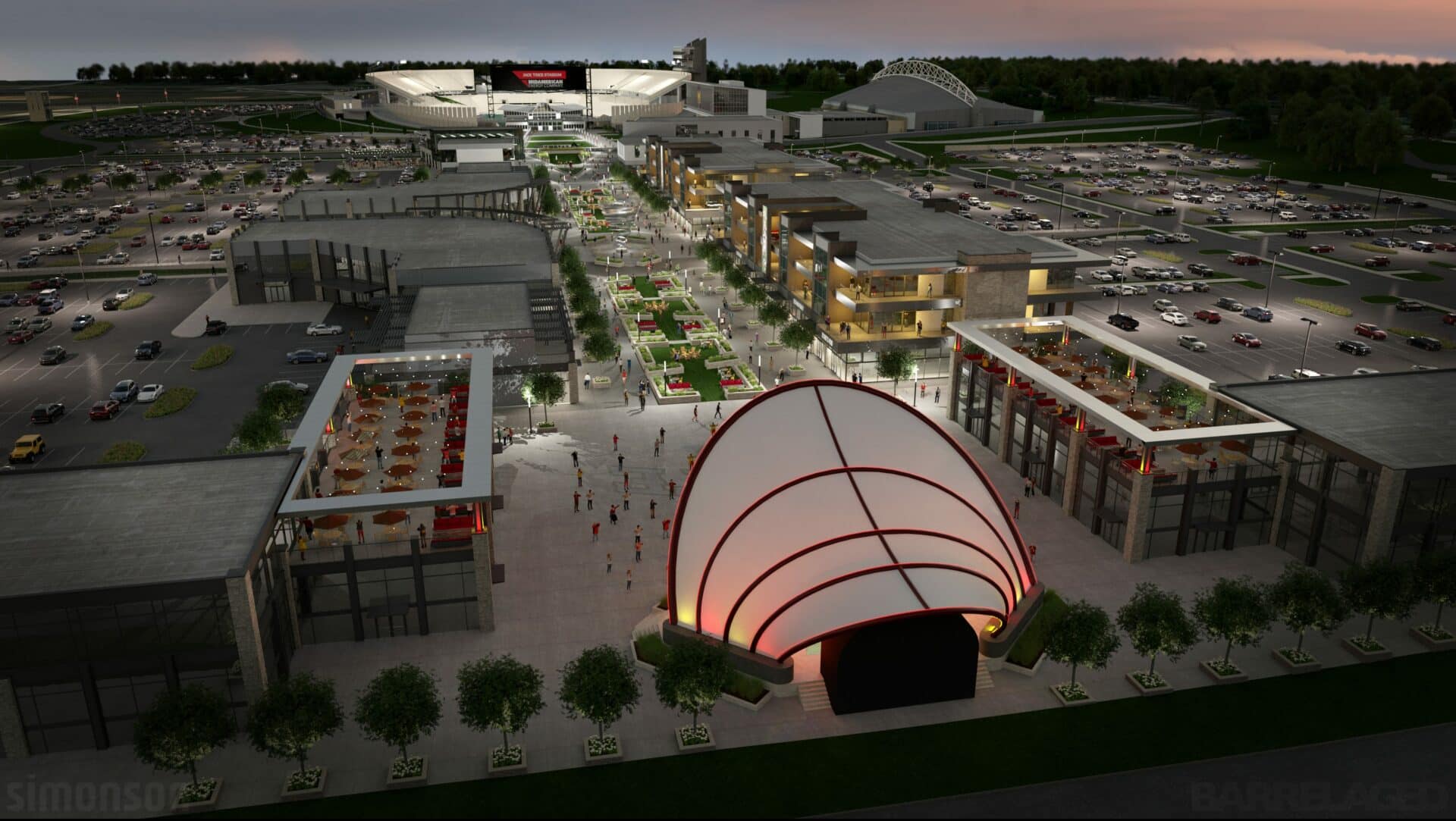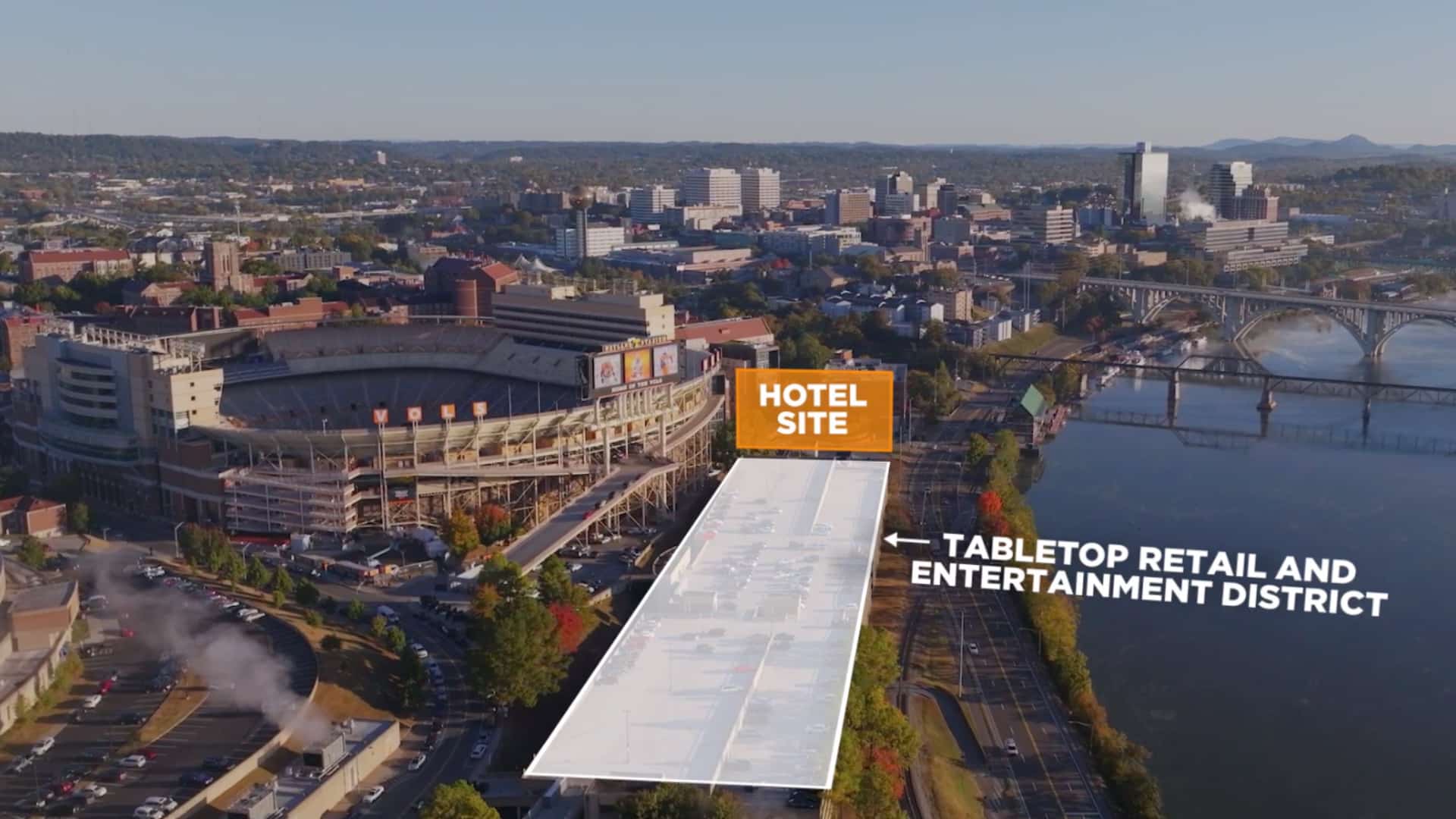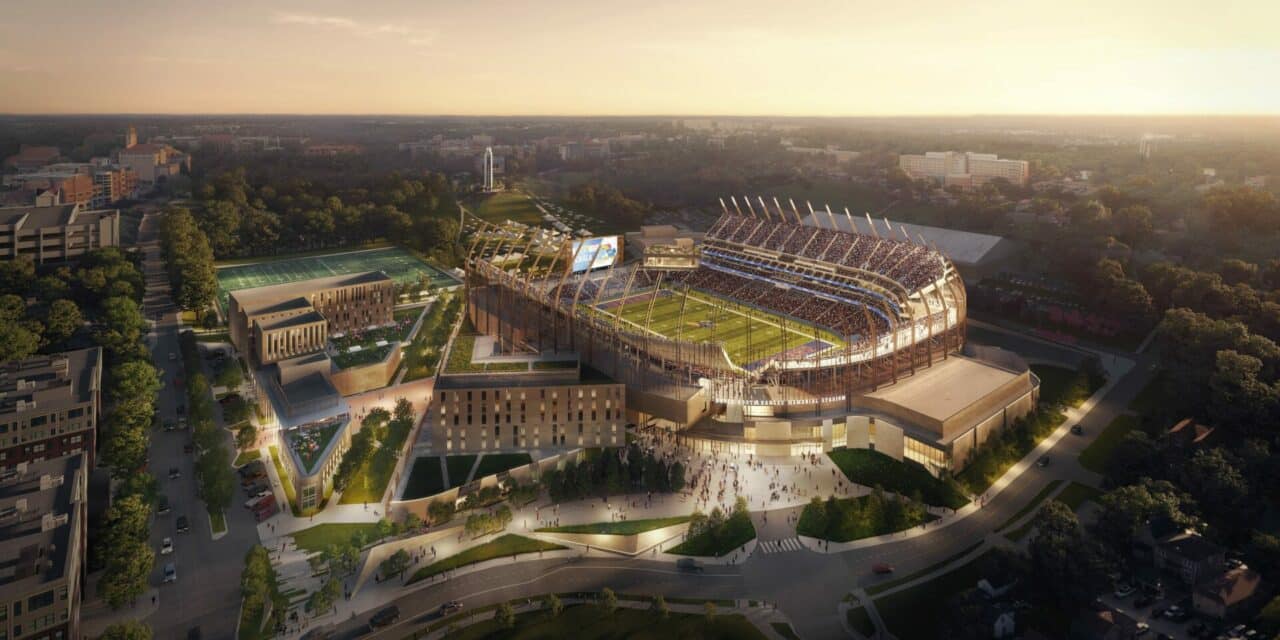ROCK CHALK RENOVATE: A rendering of the $300 million facelift of David Booth Kansas Memorial Stadium shows new buildings tied to the Gateway District. (Courtesy HNTB/Multistudio)
The mixed-use development trend tied to sports venues in the big leagues has trickled down to the college space with greater frequency as universities start to embrace the entrepreneurial spirit that’s led to profitable ventures in the pros, such as Titletown, the Ice District and Texas Live!
Kansas, Tennessee, South Carolina and Iowa State are among the Power 5 schools in various stages of planning retail and entertainment districts connected to their football stadiums.
On a smaller scale, the University of Missouri-Kansas City is pursuing an entertainment district as part of building a new 5,000-seat arena on campus.
For most of these projects, schools are seeking private developers to be their financing partner for mixed-use components with boutique hotels and conference centers, retail stores, bars, restaurants and live music venues.
Athletic directors and school administrators principally involved in the developments say they’re driven by the need to find new sources of revenue to support traditional alumni donations, which aren’t as plentiful as in the past, considering the high fees schools currently charge for game tickets and seat donations.
The districts are geared to help schools book more events at their sports facilities and create year-round destinations apart from six to seven home football games, along with providing more game day dining and entertainment options.
In Ames, Iowa and Lawrence, Kansas, project officials say the conference centers fill a need in their cities that don’t currently have a dedicated convention facility to bring more visitors and tourism dollars to town.
In some cases, the incremental revenue produced through tenant leases extend to much-needed upgrades to other venues on campus, such as Hilton Coliseum and Stephens Auditorium, Iowa State’s basketball arena and performing arts center. Both are 50-plus years old.
“We’re starting to see more of these proposals in the collegiate market, all (controlled) by the athletic department, to help fund major projects on campus,” said Peter Muther, national sports business development leader with DLR Group, an architect in Kansas City. “Two projects in our backyard have that developer-led concept.”
In general, the business model has proven effective across the big leagues. Virtually every new arena and stadium built at the highest level of sports is connected to mixed-use developments.
It’s been done in the college market as well but with fewer concrete examples.

CYCLONE ZONE: A rendering of CyTown, Iowa State’s mixed-use district under construction, shows a small amphitheater anchoring the end opposite Jack Trice Stadium. Most new arena and stadium projects in the top professional sports are connected to mixed-use developments. Fewer examples exist at the collegiate level. (Courtesy Iowa State)
One of the biggest hurdles is shifting the conservative mindset in a college setting to a more progressive way of thinking, said Tim Hickman, a consultant and former sports administrator for 21 years at the University of Missouri, including a decade running Hearnes Center, the school’s old basketball arena.
Availability of land plays a key role in building the districts, along with finding the revenue streams required for the ongoing operation of those venues apart from the upfront capital to build them. In that respect, some schools may be set up better than others, Hickman said.
South Carolina, for one extreme example, has 800 acres of undeveloped school property next to Williams-Brice Stadium along the Congaree River it’s targeting for mixed-use to help generate funding for improvements to the Gamecocks’ 77,559-seat facility in Columbia.
“We’ve seen an explosion of (schools) trying to nibble around the edges right now,” said Jamie Pollard, Iowa State’s athletic director. “Unfortunately, state institutions are not the most entrepreneurial and this is a little bit of risk-taking. We’re late to the party on concepts like this, but you’re going to see more because the historical revenue streams are drying up.”
The University of Central Florida, for one, was ahead of the curve. Sixteen years ago, UCF opened the Dixon Athletics Village as part of a master plan to transform a commuter school in Orlando growing at a rapid pace into a cohesive on-campus community. The project was tied to UCF’s construction of a new arena and football stadium, both of which opened in 2007, the same year as the athletics village.
On its own, the athletics village encompasses The Towers at Knights Plaza, a four-dorm complex housing 2,000 students, plus 183,000 square feet of retail space with tenants such as Barnes & Noble, Domino’s, Subway, Jimmy John’s and Starbucks.
At that time, Central Florida, under the direction of Athletic Director Steve Orsini, now director of regional development at Notre Dame, hired KUD International to develop the athletics village and pay for it.
“It’s the way we should be thinking,” said Tennessee Athletic Director Danny White, who served as Central Florida’s athletic director for six years before taking over at Tennessee in 2021. “There’s no way that arena would have happened without that level of creative thinking.”
In Knoxville, Tennessee, the SEC school is planning an entertainment district next to Neyland Stadium on the southeast side of the building, along the Tennessee River. UT is in the process of finding a developer to partner on the construction of a hotel, condominiums, a conference center, retail shops and restaurants.
The district concept was an extension of planning $337 million in renovations to Neyland Stadium, a separate project funded through traditional philanthropy and revenue tied to new premium seat options. As school officials worked through that project, they recognized space was available for new riverfront development.
“This university has not done that before in our history,” White said, “but with the size of our student population, the passion of our fan base and the proximity of our 22,000-seat arena and 102,000-seat football stadium, we felt there was a cool opportunity to enhance the game day experience and make better use of our existing assets.”
The district would provide scenic views over the river and the Smoky Mountains. From the vantage point of a developer, building a hotel next to the stadium would open up many opportunities for special events, whether it’s conferences or weddings that White said could help fill Neyland’s club spaces that aren’t used much outside of football season.
At KU, school officials have embarked on a $300 million facelift of David Booth Kansas Memorial Stadium, connected to the Gateway District, a proposed mixed-use development with a hotel and conference center, and potentially a healthcare facility, Class A office space and an outdoor music venue.
Similar to Tennessee, KU is searching for a developer to partner on the Gateway District concept, with a vision to create a new front door to the north side of campus.
The project coincides with tremendous economic growth in Lawrence and Kansas City, which sits 40 miles east of campus, said Karla Leeper, the school’s vice chancellor for strategic communications and public affairs.
The mixed-use piece would eliminate a big chunk of the surface parking lots surrounding Memorial Stadium, which school officials see as a waste of space and an opportunity for new development.
At the same time, they recognize a parking solution must be found to replace that space on football game days.
“We can take advantage of some of the things at the university and in the city to create a much better entryway,” Leeper said. “It would give us a great football experience that’s very important for our traditions, our fans and our role in a Power 5 conference. We can use it to help improve the nature of the campus experience for students, faculty and our (residential) neighbors.”
In Kansas City, designers with HNTB, project architect for Memorial Stadium renovations connected to the proposed district, applaud KU for their bold vision in going down the same path as the pros.
Gerardo Prado, HNTB’s vice president and national sports practice leader, is a Kansas alum and intimately familiar with the 102-year-old stadium’s shortcomings, as well as its storied traditions, such as the graduation day procession from the top of the hill flowing into the venue.

BIG ORANGE: University of Tennessee has planned an entertainment district next to Neyland Stadium and is in the process of finding a developer partner. (Courtesy Tennessee)
“I haven’t seen anything quite like it in 27 years at HNTB,” Prado said, “where they’re trying to integrate a conference facility to host regional meetings and attract new visitors. There’s alignment between the chancellor, the athletic department and donors. Everybody is up in arms about the loss of parking and tailgating, but you’re starting to see the shift with valuable land for hotels, restaurants and live music. It’s about the best use of every square foot of space. You may park further away from the venue, which happens at every urban destination. It’s not a bad thing.”
Ryan Gedney, HNTB’s national design director, has experience designing NHL arenas in Detroit, Michigan, and Edmonton, Alberta, both connected to mixed-use developments. Gedney sees parallels between those two projects and KU’s Gateway District.
“Kansas is right on track with that as far as doing it differently,” he said. “That’s what I’m most excited about, the opportunity there to explore design between buildings that are typically physically separate. It’s an unbelievable site, an amazing parklike setting with the hill and a lot of beautiful traditions that you can build on in tandem with the district’s aspiration.”
At Iowa State, CyTown, a $200 million project named after the Cyclones, the school’s team brand, is already taking shape, starting with construction of new roads, sidewalks and parking on the east side of Jack Trice Stadium, the school’s football venue.
The total 40-acre development, expected to be completed in 2025, is modeled after Titletown, the Green Bay Packers’ entertainment district, and Kansas City Power & Light and Texas Live!, two destinations created by The Cordish Cos., a Baltimore, Maryland, developer.
CyTown was driven by the opportunity to repurpose underutilized land to generate new revenue and energize the area surrounding the football stadium and Hilton Coliseum, said Athletic Director Jamie Pollard.
The project originated with the ISU athletic department gaining control of the parking lots around the stadium, arena and other entertainment venues on campus because donor parking is such a big piece of revenue with its annual fund, Pollard said.
As part of the new development, Iowa State signed a deal with the city of Ames for 60 years. The school generates revenue from property taxes tied to CyTown and the leases signed with tenants for the district, Pollard said.
Iowa State is responsible for financing the first phase of CyTown, including infrastructure upgrades, utility work and construction of a medical clinic and a small amphitheater.
To date, the school’s investment stands at about $40 million. Iowa State could potentially use third-party developers to build retail and office space in future phases, similar to what the Packers did, Pollard said.
McFarland Clinic, the first tenant and an existing ISU athletics sponsor, will pay for constructing the 60,000-square-foot facility. Iowa State will own the building, and in turn, give the healthcare company free rent for the duration of their lease. Iowa State is working with a local concert promoter to develop the 2,000-capacity amphitheater.
New dining options will be part of future phases. Pollard pointed to Texas Live!, the bar and restaurant complex that sits next to Globe Life Field, the Texas Rangers’ ballpark in Arlington in which the MLB team is a partner. He likes the Cordish model, with one operator controlling the property with the flexibility to switch concepts if one eatery doesn’t pull its weight.
In Ames, the question is what effect CyTown would have on Campustown, a stretch of existing bars and restaurants situated one mile northwest of Jack Trice Stadium. To address that situation, about five years ago, as the plans for the district began, Pollard joined Discover Ames, the city’s convention and visitors bureau, to learn more about what’s going on in that part of the community.
It turns out city leaders were supportive of CyTown, because they view the overall development as generating more business for all parties involved.
“Some of them feel like it’s been forever since they’ve relied on the university to get a return as Campustown has fallen behind the times,” Pollard said. “It’s really come down to shared needs. We didn’t have a solution to the arts issue (on campus), so this is a viable solution. If it doesn’t work, at least we tried, because not doing it wasn’t getting us anywhere.”







